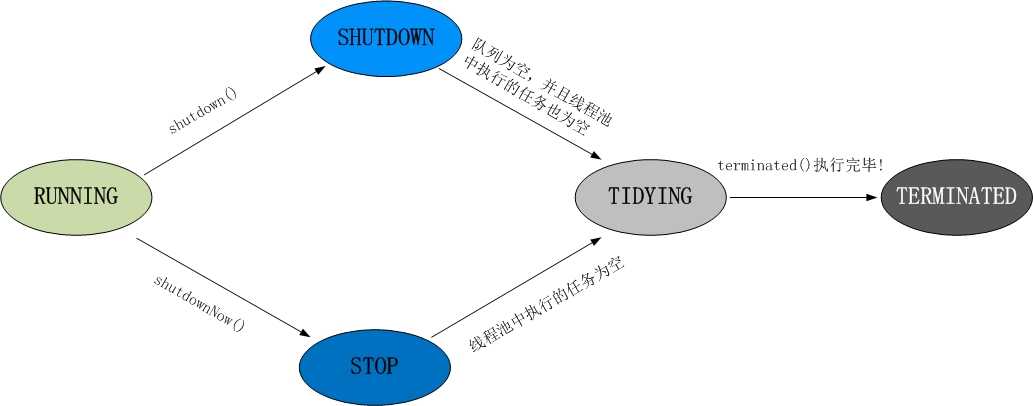Java多线程系列--“JUC线程池”04之 线程池原理
Posted
tags:
篇首语:本文由小常识网(cha138.com)小编为大家整理,主要介绍了Java多线程系列--“JUC线程池”04之 线程池原理相关的知识,希望对你有一定的参考价值。
本章介绍线程池的生命周期。
线程有5种状态:新建状态,就绪状态,运行状态,阻塞状态,死亡状态。线程池也有5种状态;然而,线程池不同于线程,线程池的5种状态是:Running, SHUTDOWN, STOP, TIDYING, TERMINATED。
线程池状态定义代码如下:
/**
* The main pool control state, ctl, is an atomic integer packing
* two conceptual fields
* workerCount, indicating the effective number of threads
* runState, indicating whether running, shutting down etc
*
* In order to pack them into one int, we limit workerCount to
* (2^29)-1 (about 500 million) threads rather than (2^31)-1 (2
* billion) otherwise representable. If this is ever an issue in
* the future, the variable can be changed to be an AtomicLong,
* and the shift/mask constants below adjusted. But until the need
* arises, this code is a bit faster and simpler using an int.
*
* The workerCount is the number of workers that have been
* permitted to start and not permitted to stop. The value may be
* transiently different from the actual number of live threads,
* for example when a ThreadFactory fails to create a thread when
* asked, and when exiting threads are still performing
* bookkeeping before terminating. The user-visible pool size is
* reported as the current size of the workers set.
*
* The runState provides the main lifecycle control, taking on values:
*
* RUNNING: Accept new tasks and process queued tasks
* SHUTDOWN: Don‘t accept new tasks, but process queued tasks
* STOP: Don‘t accept new tasks, don‘t process queued tasks,
* and interrupt in-progress tasks
* TIDYING: All tasks have terminated, workerCount is zero,
* the thread transitioning to state TIDYING
* will run the terminated() hook method
* TERMINATED: terminated() has completed
*
* The numerical order among these values matters, to allow
* ordered comparisons. The runState monotonically increases over
* time, but need not hit each state. The transitions are:
*
* RUNNING -> SHUTDOWN
* On invocation of shutdown(), perhaps implicitly in finalize()
* (RUNNING or SHUTDOWN) -> STOP
* On invocation of shutdownNow()
* SHUTDOWN -> TIDYING
* When both queue and pool are empty
* STOP -> TIDYING
* When pool is empty
* TIDYING -> TERMINATED
* When the terminated() hook method has completed
*
* Threads waiting in awaitTermination() will return when the
* state reaches TERMINATED.
*
* Detecting the transition from SHUTDOWN to TIDYING is less
* straightforward than you‘d like because the queue may become
* empty after non-empty and vice versa during SHUTDOWN state, but
* we can only terminate if, after seeing that it is empty, we see
* that workerCount is 0 (which sometimes entails a recheck -- see
* below).
*/
private final AtomicInteger ctl = new AtomicInteger(ctlOf(RUNNING, 0));
private static final int COUNT_BITS = Integer.SIZE - 3;
private static final int CAPACITY = (1 << COUNT_BITS) - 1;
// runState is stored in the high-order bits
private static final int RUNNING = -1 << COUNT_BITS;
private static final int SHUTDOWN = 0 << COUNT_BITS;
private static final int STOP = 1 << COUNT_BITS;
private static final int TIDYING = 2 << COUNT_BITS;
private static final int TERMINATED = 3 << COUNT_BITS;
// Packing and unpacking ctl
private static int runStateOf(int c) { return c & ~CAPACITY; }
private static int workerCountOf(int c) { return c & CAPACITY; }
private static int ctlOf(int rs, int wc) { return rs | wc; }
说明:
ctl是一个AtomicInteger类型的原子对象。ctl记录了"线程池中的任务数量"和"线程池状态"2个信息。
ctl共包括32位。其中,高3位表示"线程池状态",低29位表示"线程池中的任务数量"。
RUNNING -- 对应的高3位值是111。
SHUTDOWN -- 对应的高3位值是000。
STOP -- 对应的高3位值是001。
TIDYING -- 对应的高3位值是010。
TERMINATED -- 对应的高3位值是011。
线程池各个状态之间的切换如下图所示:

1. RUNNING
(01) 状态说明:线程池处在RUNNING状态时,能够接收新任务,以及对已添加的任务进行处理。
(02) 状态切换:线程池的初始化状态是RUNNING。换句话说,线程池被一旦被创建,就处于RUNNING状态!
道理很简单,在ctl的初始化代码中(如下),就将它初始化为RUNNING状态,并且"任务数量"初始化为0。
private final AtomicInteger ctl = new AtomicInteger(ctlOf(RUNNING, 0));
2. SHUTDOWN
(01) 状态说明:线程池处在SHUTDOWN状态时,不接收新任务,但能处理已添加的任务。
(02) 状态切换:调用线程池的shutdown()接口时,线程池由RUNNING -> SHUTDOWN。
3. STOP
(01) 状态说明:线程池处在STOP状态时,不接收新任务,不处理已添加的任务,并且会中断正在处理的任务。
(02) 状态切换:调用线程池的shutdownNow()接口时,线程池由(RUNNING or SHUTDOWN ) -> STOP。
4. TIDYING
(01) 状态说明:当所有的任务已终止,ctl记录的"任务数量"为0,线程池会变为TIDYING状态。当线程池变为TIDYING状态时,会执行钩子函数terminated()。terminated()在ThreadPoolExecutor类中是空的,若用户想在线程池变为TIDYING时,进行相应的处理;可以通过重载terminated()函数来实现。
(02) 状态切换:当线程池在SHUTDOWN状态下,阻塞队列为空并且线程池中执行的任务也为空时,就会由 SHUTDOWN -> TIDYING。
当线程池在STOP状态下,线程池中执行的任务为空时,就会由STOP -> TIDYING。
5. TERMINATED
(01) 状态说明:线程池彻底终止,就变成TERMINATED状态。
(02) 状态切换:线程池处在TIDYING状态时,执行完terminated()之后,就会由 TIDYING -> TERMINATED。
参考:
http://www.cnblogs.com/skywang12345/p/3509960.html
以上是关于Java多线程系列--“JUC线程池”04之 线程池原理的主要内容,如果未能解决你的问题,请参考以下文章